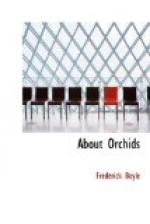Remark, in the first place, the low, unshaded range of houses devoted to hybridization, a contrast to those lofty structures, a hundred yards long or more, where plants merely flourish and bloom. Their span roofs one may touch with the hand, and their glass is always newly cleaned. The first and last demand of the hybridizer is light—light—eternally light. Want of it stands at the bottom of all his disappointments, perhaps. The very great majority of orchids, such as I refer to, have their home in the tropics; even the “cool” Odontoglots and Masdevallias owe that quality to their mountaineering habit, not to latitude. They live so near the equator that sunshine descends almost perpendicularly—and the sun shines for more than half the year. But in this happy isle of ours, upon the very brightest day of midsummer, its rays fall at an angle of 28 deg., declining constantly until, at midwinter, they struggle through the fogs at an inclination of 75 deg.. The reader may work out this proportion for himself, but he must add to his reckoning the thickness of our atmosphere at its best, and the awful number of cloudy days. We cannot spare one particle of light. The ripening seed must stand close beneath the glass, and however fierce the sunshine no blind may be interposed. It is likely that the mother-plant will be burnt up—quite certain that it will be much injured.
This house is devoted to the hybridizing of Cypripediums; I choose that genus for our demonstration, because, as has been said, it is so very easy and so certain that an intelligent girl mastered all its eccentricities of structure after a single lesson, which made her equally proficient in those of Dendrobes, Oncidiums, Odontoglots, Epidendrums, and I know not how many more. The leaves are green and smooth as yet, with many a fantastic bloom, and many an ovary that has just begun to swell, rising amidst the verdure. Each flower spike which has been crossed carries its neat label, registering the father’s name and the date of union.
Mr. Maynard takes the two first virgin blooms to hand: Cypripedium Sanderianum, and Cypripedium Godefroyae, as it chances. Let us cut off the lip in order to see more clearly. Looking down now upon the flower, we mark two wings, the petals, which stood on either side of the vanished lip. From the junction of these wings issues a round stalk, about one quarter of an inch long, and slightly hairy, called the “column.” It widens out at the tip, forming a pretty table, rather more than one-third of an inch long and wide. This table serves no purpose in our inquiry; it obstructs the view, and we will remove it; but the reader understands, of course, that these amputations cannot be performed when business is intended. Now—the table snipped off—we see those practical parts of the flower that interest us. Beneath its protection, the column divides into three knobbly excrescences, the central plain, those on either side of it curling back and down, each bearing at its extremity a pad, the size of a small pin’s head, outlined distinctly with a brown colour. It is quite impossible to mistake these things; equally impossible, I hope, to misunderstand my description. The pads are the male, the active organs.




